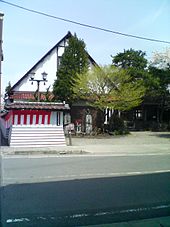Kōminkan

Kōminkan ( Japanese 公民 館 , literally: "Public Citizens Hall "; common translation: "Community Center") is a mixture of a Japanese cultural center and a community college. Kōminkans offer structured learning programs in arts, sports, handicrafts and cultural activities for children, teenagers and seniors. They are generally funded and managed by local authorities.
Together with libraries , archives and museums , they were targets of the SaveMLAK project to be protected after the Tōhoku earthquake in 2011 .
history
Kōminkan were in operation since the early 1940s, although many were founded after the Second World War under the Shakai-kyōiku-hō ( 社会 教育 法 , German "Society Education Act ") of 1949, in Section 5 (Articles 20-42) the legal bases are laid down.
The Kōminkan were specifically designed to provide cultural support for post-war communities, "for celebration, education, learning and other activities that help rebuild communities after the devastation and upheaval of the post-war period"
According to Article 20 of the Japanese Shakai-kyōiku-hō, “[they] provide education adapted to the needs of real life and academic and cultural activities to the population residing in certain areas, such as a large city, town or village involves. Kōminkan should contribute to the cultivation of residents, improve health, develop character, enliven daily culture and promote social welfare. "
With the establishment of the Kōminkan, the Japanese government invested considerable financial resources since the 1940s. In 1979 the national government spent 10 billion yen on infrastructure and administration.
numbers
In 2008 there were 15,943 Kominkans in Japan, more than there were secondary schools in the country. There were 50,771 people employed in Japan, with an average of three employees per Kōminkan. According to the study, Japanese citizens participated in Kōminkan activities 256 million times a year in 2008, with an average of two visits a year.
Public use
According to Article 23 of the Shakai-kyōiku-hō , Kōminkan should not be used solely to hold commercial events or to do work for the benefit of a specific party or political candidate. In addition, community centers should not support any particular religion, sect, or cult.
Individual evidence
- ↑ James E. Thornton: Education in the Third Age: Canadian and Japanese Perspectives . Ed .: Sharon A. Harold. Pacific Educational Press, Vancouver 1991, ISBN 978-0-88865-078-8 (English).
- ^ Makoto Okamoto: Activity and task of the saveMLAK and aid for library . In: Journal of Information Processing and Management . tape 54 , no. 12 , 2012, p. 808–818 , doi : 10.1241 / johokanri.54.808 , bibcode : 2012JIPM ... 54..808O (English).
- ↑ a b c Takaaki Iwasa: It is Time for Japanese Kominkan to Flower Again . In: dvv international - Institute for International Cooperation of the German Adult Education Association (Hrsg.): Adult Education and Development . No. 74 , 2010 (English, iiz-dvv.de [accessed on August 15, 2013]).
- ↑ Takaaki Iwasa: kominkan in Japan. (PDF; 3 MB) December 11, 2009, p. 132 , accessed on August 15, 2013 (English): "for celebration, education, learning and other activities that contributed to re-building the communities after the devastation and upheavals of the was aftermath. "
- ^ Hideki Maruyama: "Social Education" System in Japan. (PDF; 258 kB) Retrieved November 25, 2013 (English).
